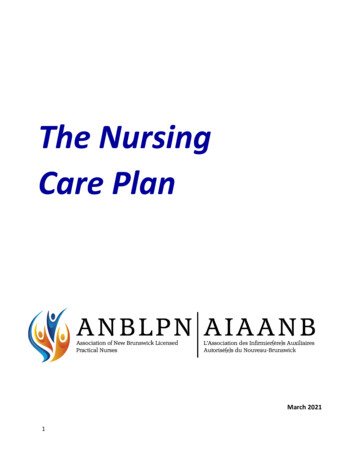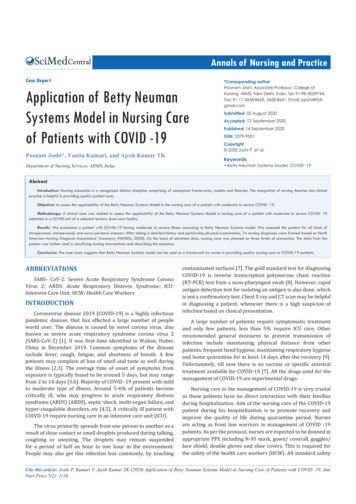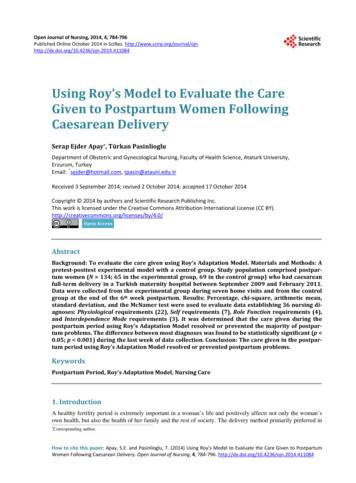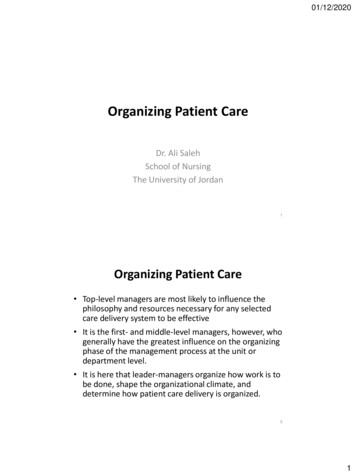
Transcription
The NursingCare PlanMarch 20211
MissionThe Association of New Brunswick Licensed Practical Nurses (ANBLPN) is the regulatory body forLicensed Practical Nurses (LPN) in New Brunswick. ANBLPNs mandate is protection of the public bypromoting the provision of safe, competent, ethical, and compassionate care. ANBLPN sets, monitors,and enforces practical nurse education, registration, and professional conduct. ANBLPN createsStandards of Practice, establishes a Code of Ethics, and develops and implements a ContinuingCompetence Program. Additionally, ANBLPN publishes documents to support the practice of LPNs inNew Brunswick.Copyright – The Association of New Brunswick Licensed Practical Nurses 2021 - All rights reserved. Nopart of this publication may be reproduced or transmitted in any form or by any means, electronic ormechanical, including photocopying, recording or by any information storage and retrieval. withoutprior written permission from publisher. A N B L P N 2 0 2 1
What is a Nursing Care Plan?The Nursing Care Plan (NCP) plays an important role in providing quality patient care as it helpsdetermine a client’s treatment, ensures consistency in care and allows the nursing team to individualizecare based on the needs of the client (Neeley, 2019). The terms care planning, plan of care and careplan are often used interchangeably, and its formation has long been a component of nursing.Historically nursing care was often implemented by way of a routine that was functional and client’sbecame names on a list according to interventions required rather than as individuals with unique careneeds (Ballantyne, 2016). As care plans evolved, they became individualized and comprehensive plansused to guide nursing care and developed in collaboration with the client. Clients should be included inthe care plan so that they are involved with the interventions rather than just having interventions doneto them (NANB, 2020).NCPs are designed to reflect a client’s priority health care needs upon admission and throughout theduration of their care (NSCN, 2019). They evolve over time as client’s needs change and are used toindicate the interventions required to address the client’s needs as well as state the expected or optimalhealth outcomes.The care plan also helps determine a client’s level of predictability and complexity based on the healthcare assessment. Consideration must be given to a client’s level of predictability and complexity todetermine which nursing care provider can best meet the needs of the client (ANBLPN & NANB, 2020).All nursing professionals play a role in assessing and evaluating a client’s health care needs and responseto treatment.Nursing Roles in Care PlanningTo fully understand the Licensed Practical Nurses (LPN) role in care planning, we first must understandthe differences between LPN and Registered Nurse (RN) practice and how it relates to legislation. BothLPNs and RNs are autonomous practitioners who make independent care decisions and as such, bothare accountable for their actions and inactions. RNs, because of their increased breadth and depth ofknowledge, practice to a broader level of professional autonomy. LPNs practice their professionalautonomy in collaboration with other health care providers as per the LPN Act (2014). However, bothLPNs and RNs are always expected to work collaboratively within the health care team.ANBLPNs Standards of Practice state that LPNs:2.5: Collaborate in the development, review, and revision of the plan of care to addressclient needs and preferences and to establish client centred goals; and2.6: Develop and/or modify the plan of care based on the concepts of individual LPNcompetence, environmental supports, and client needCCPNR, 2020 A N B L P N 2 0 2 1
NANBs Standards of Practice state that RNs: 2.2: Establish the initial nursing plan of care based on a comprehensive assessment; and2.3: Monitor the effectiveness of the plan of care and revises the plan as needed in collaborationwith the client and the health care team (NANB, 2019).Based on legislation and the respective standards, ANBLPN interprets this to mean that LPNs areinvolved in the initial care plan in collaboration with the health care team. Furthermore, LPNs maydocument their assessment findings to develop and/or modify the care plan within their individualcompetence. LPNs are expected to communicate their findings to the RN and continue to collaboratewith the health care team on the NCP. Both LPNs and RNs must share their respective knowledge basesand perspectives about the client and work together on the plan of care throughout the duration of theclient’s care.Development of the Nursing Care PlanNCPs are used to create evidence-based, holistic care, to record care/interventions given, and tomeasure outcomes because of the care/interventions that have been given (Ballantyne, 2016). Thedevelopment of the initial NCP involves: Developing plans to address any unexpected, new, or worsened problems;Identify and coordinate initial care resources, referrals, or care to support clients in achievingtheir care goals;Customizing nursing interventions to manage complex or high-risk issues; andEvaluate the overall effectiveness of the NCP (NSCN, 2019).Though LPNs are involved in all aspects of the development of the care plan, they must also do so incollaboration with the RN. RNs can independently develop initial care plans across all practiceenvironments, whereas LPNs may develop the initial care plan in collaboration with the RN or they maydevelop a draft care plan that gets validated by the RN through the collaboration process. The LPN mustshare the draft care plan with the RN and the plan will be validated by the RN and LPN when bothnursing professionals are satisfied that the NCP is meeting the client’s care needs (NSCN, 2019).An LPNs level of autonomy varies in relation to the client’s needs (level of predictability and complexity),the nursing professional’s competence and the practice environment. The more complex the client’sneeds and the more dynamic the practice environment, the greater need there is for the LPN tocollaborate with the RN (ANBLPN & NANB, 2020). Due to the changing health care system, there may bepractice environments where an RN is not available or part of the health care team. In thesecircumstances, LPNs may collaborate with the most appropriate health care provider to contribute toand develop the plan of care (NSCN, 2020).Client AssessmentsPerforming an assessment is the first step of the nursing process. Client assessments provide thefoundation of the NCP in terms of its development and the results of the assessment provide a baseline A N B L P N 2 0 2 1
to evaluate the effectiveness of care/interventions given to the client. NCPs cannot be developed orevaluated without a client assessment being performed.Both LPNs and RNs may collect client data from the assessment and record this data on the NCP. LPNsand RNs have an obligation to communicate and collaborate on any data they have collected from theclient throughout the assessment process.As per the Standards of Practice for LPNs, LPNs are authorized to perform assessments on any client andacross all practice settings. However, when assessment findings are unexpected or rapidly changing, theLPN has a professional obligation to collaborate with the RN. The RN has a broader scope of practicedue to their increased breadth and depth of knowledge and therefor they must be consulted with sothat they can rapidly analyze, interpret and act independently on assessment findings that areunexpected or rapidly changing.ANBLPNs Standards or Practice state that LPNs:2.8: Apply the nursing process (assess, diagnose, plan, implement, and evaluate) to identifythe implications of interventions that impact client outcomes.2.10: Assess client and collaborate with the appropriate person(s) when client status ischanged, new or not as anticipated.CCPNR, 2020Implementing the Nursing Care PlanLPNs may implement a newly developed modified care plan in collaboration with the RN. They mayautonomously implement an on-going established care plan providing the client is meeting theiranticipated outcomes. LPNs use established care plans to guide their clinical decisions and are expectedto: Perform ongoing client assessments;Evaluate the client’s response to interventions;Interpret findings by comparing assessment and evaluation data to the baseline data; andAdjust the plan of care based on their interpretations.LPNs may autonomously revise or modify the NCP providing these changes are due to the clientachieving their intended outcomes as they progress through the care plan. LPNs must communicate anyrevisions or modifications they make to the RN (NSCN, 2019).Evaluation of the Nursing Care PlanCare plans are evaluated to determine if clients have met their goals. The evaluation is based oncomparing the client assessment data to the expected outcomes in the care plan. A N B L P N 2 0 2 1
LPNs may autonomously evaluate a client’s response to nursing care and interventions. If the responsesare anticipated, the LPN may independently move forward with the plan of care. However, if theresponses are unexpected LPNs are obligated to collaborate with the RN based on these findings tomodify the plan of care.ConclusionNursing care plans are a valuable and necessary tool to ensure clients receive safe, competent, ethical,and compassionate care. When we assess and plan for client outcomes it results in positive outcomessuch as increased communication among the health care team, clarifying whom the best care providermay be to help ensure the client reaches their goals and they also give the health care team the abilityto determine the success of the interventions that have been implemented (NANB, 2019).Positive patient outcomes are more likely when the entire nursing team is involved, and when theyunderstand the client’s goals and what the plan is to achieve those goals. Each patient is different andtherefor, a ‘one size fits all’ approach will not work (Neeley, 2019). Individualized care plans developedwith the client will empower clients as it allows clients to have a sense of control and the ability tocontribute to their own health care needs.The nursing care plan is a core function of nursing. It is imperative that LPNs understand the role theyplay regarding care plans and the importance of collaborating with RNs based on a client’s needs andthe practice environment they work in. A N B L P N 2 0 2 1
ReferencesAssociation of New Brunswick Licensed Practical Nurses. (2020). Nursing Intraprofessional Guidelines:LPNs and RNs Working Together. https://www.anblpn.ca/resources/working together.pdfBallantyne, H. (2016). Developing Nursing Care Plans. Nursing Standard 30 (26) p. 51-57Canadian Council of Practical Nurse Regulators. (2020). Standards of Practice for LPNs.https://www.anblpn.ca/resources/STANDARDS OF PRACTICE.pdfNeeley, Carolyn Kay. (2019). Purpose of Nursing Care Plans. ng-care-plans.htmlNova Scotia College of Nursing. (2019). Nursing Care Plans: Guidelines for cuments/resources/NursingCarePlan 0.pdfNurses Association of New Brunswick. (2020). Care Planning: An Essential Element of RN urses Association of New Brunswick. (2019). Standards of Practice for Registered 19-RNPracticeStandards-E-web.pdf A N B L P N 2 0 2 1
What is a Nursing Care Plan? The Nursing Care Plan (NCP) plays an important role in providing quality patient care as it helps determine a client's treatment, ensures consistency in care and allows the nursing team to individualize care based on the needs of the client (Neeley, 2019). The terms care planning, plan of care and care










